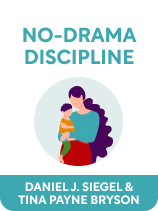

This article is an excerpt from the Shortform book guide to "No-Drama Discipline" by Daniel J. Siegel and Tina Payne Bryson. Shortform has the world's best summaries and analyses of books you should be reading.
Like this article? Sign up for a free trial here .
Why is connecting with your kids a part of the No-Drama Discipline process? What three strategies can you use to make a connection?
In their book No-Drama Discipline, Siegel and Bryson explain that the second step in their No-Drama Discipline method is to make a connection with your child. You can do that through touch (such as hugging), affirming their emotions, and listening while your child talks.
Continue below to learn why making a connection with your child is important to the discipline process.
Discipline Step 2: Making a Connection
Once you’re in the right frame of mind to discipline mindfully, the next step in Siegel and Bryson’s discipline approach is connection: meeting your child where they are, empathizing with them, and helping them calm down from strong emotions.
According to the authors, connecting with your kids is an essential step because it sets the stage for kids to listen and learn. When kids feel strong emotions like anger or frustration, their lower brains take control and drown out the input of the rational upper brain. This means kids lose access to upper brain skills like emotional regulation and processing new information. (Kids in this state may be inconsolable—which parents often mistake for a willful tantrum.) The authors argue that trying to discipline children effectively when they’re in this state is futile.
(Shortform note: Daniel Goleman describes these lower brain takeovers (or “emotional hijackings,” as he calls them) in more detail in Emotional Intelligence. According to Goleman, research shows that even children with high IQs perform poorly in school when they’re under emotional stress and the lower brain takes over. This supports Siegel and Bryson’s claim that kids genuinely won’t be able to learn new information when their lower brain has hijacked their upper brain.)
Connection, according to Siegel and Bryson, is the solution to this problem. Empathic connection helps children calm the raging lower brain to the point that it no longer drowns out the upper brain. Then, the upper brain has a chance to chime in with logic, empathy, and problem-solving skills—meaning children will be more able to listen and understand when you teach them a new, more appropriate way to behave.
The authors note an added bonus to this method: Over time, using connection to help calm the lower brain helps children strengthen the connections between their upper and lower brains so that they can more effectively rein in the lower brain’s strong reactions. In other words, connection not only regulates kids’ emotions in the moment, but it also strengthens their brains’ ability to regulate their own emotions. Eventually, they’ll be able to use that skill on their own, without as much help from you.
| Connection Is a Key Part of “Coregulation” What Siegel and Bryson are describing here is what other child development experts call “coregulation,” or the process of adults helping children manage strong emotions. The empathic connection that Siegel and Bryson mention is just one aspect of coregulation. According to developmental scientists, to effectively coregulate, adults should also provide a structured environment (including a predictable routine) and explicit coaching of emotional self-regulation skills (such as identifying emotions, calming down, and seeing a situation from someone else’s perspective). Additionally, the reason that kids need less coregulation from parents over time isn’t just a matter of upper brain practice, as Siegel and Bryson suggest—it’s also a matter of overall development. For example, infants need more coregulation than older kids by default because they haven’t yet learned how to control even the most basic bodily functions; they need an adult’s help not just to calm down but also to regulate their body temperature and stress hormone levels. On the other hand, older children with typical development have already mastered those skills, so they need less help from parents—even if they haven’t had deliberate practice regulating their own emotions. |
Strategies for Connection
Here are three strategies Siegel and Bryson recommend for establishing connection with your kids:
Connection Strategy 1: Use Your Body
Siegel and Bryson argue that the most powerful way to soothe your child when she’s upset is through touch. Positive touch (like hugs or rubbing your child’s back) releases stress-relieving hormones in the brain, which helps children (and adults) calm down. (Shortform note: In Parenting From the Inside Out, Siegel and Hartzell note that it’s especially important to be fully calm and mindful before touching your child: If you’re still angry or upset with them, gentle touch can quickly turn into harmful touch, which can be particularly damaging. For example, if you’re still upset, you might accidentally grab your child a little too roughly, even if that wasn’t your intention.)
To make your child feel even safer and more open to connection, the authors recommend positioning yourself below her eye level—for example, by sitting on the ground while she stands in front of you or sits on a chair. This posture communicates to the primal, animal part of her brain that you’re not a threat. (Shortform note: Getting down on the ground is just one of many ways to make yourself appear less threatening. For example, with older children, you can also sit shoulder to shoulder while you talk to them. The lack of eye contact in this approach makes kids and teens feel safer.)
Connection Strategy 2: Acknowledge and Affirm Your Child’s Emotions
Once your child is calm, Siegel and Bryson recommend acknowledging and affirming your child’s emotions, even if you’re not happy with the way she expressed those emotions. When children are upset, having a parent communicate that their feelings are valid helps them calm down faster because they feel understood.
According to the authors, affirmation has two steps. First, identify the feeling. For example, if your child is crying and stomping their feet, you might say, “I can see you’re feeling really angry right now.” This not only helps children feel understood, but it also helps them learn to identify their own emotions. (Shortform note: You might not think to do this until children are old enough to understand what you say, but some parenting experts recommend identifying feelings even with babies as a way to get into the habit. For example, you might say, “I hear you, you don’t want to get out of the tub—the air is cold!”)
Second, express empathy. Challenge yourself to understand why your child is feeling so strongly about the situation and communicate that you understand why they’re so upset. For example, you might say to your angry child, “I know you really wanted to go to the mall today, and you’re angry that we had to reschedule. I would feel angry too if my plans changed like that.” (Shortform note: When you empathize with your children, keep their limited life experience in mind. For example, if your toddler reacts to spilling her juice as though it’s the worst thing that’s ever happened to her, keep in mind that it might actually be the worst feeling she’s yet experienced in her short life, and empathize accordingly.)
Connection Strategy 3: Let Your Child Do the Talking
As you connect with your child, the authors advise focusing on listening rather than lecturing, arguing, or explaining. Keep in mind that language is an upper brain function—so when kids are feeling strong emotions that activate their lower brains, they’re not able to process language, and lectures aren’t helpful.
(Shortform note: In addition to strengthening your connection with your child, listening offers other benefits. For example, regularly listening to your children establishes open communication, which means they’ll be more likely to share their thoughts and struggles openly with you as they get older. Additionally, modeling listening skills for your child will help them develop important social skills that can help them form and maintain healthy relationships. Meanwhile, lecturing is ineffective because even if your child does process what you’re saying, they’ll feel hurt that you’ve spent so long talking about how “bad” they are, and they’ll respond with defensiveness and resentment.)

———End of Preview———
Like what you just read? Read the rest of the world's best book summary and analysis of Daniel J. Siegel and Tina Payne Bryson's "No-Drama Discipline" at Shortform .
Here's what you'll find in our full No-Drama Discipline summary :
- Ways to empower parents to discipline their children without the drama
- Why you should discipline mindfully, with the goal of connecting with your child
- How to teach your child why a behavior is unacceptable






